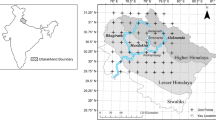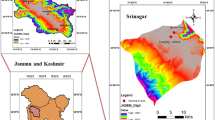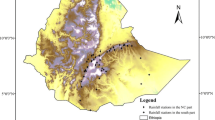Abstract
Understanding the changes in the frequency characteristics of extreme rainfall can lead to building an appropriate frequency model which ultimately plays a pivotal role in assessing flood risk. However, little attention is invested into the temporal changes of frequency characteristics of extreme rainfall in a monsoon dominated region like Bangladesh. This study assesses the temporal change in extreme rainfall frequency behaviour using a number of methods in an innovative way based on annual maximum rainfall data of 1-day duration over Bangladesh. The probable teleconnection of extremes with large-scale climate indices is also examined. Results suggested that the extreme rainfall data can be aptly described by the generalised extreme value distribution. The trend analysis shows interesting results: over 60% of stations show significant trends in all the three parameters; amongst them, about 75% show significant negative trends of location parameter which lead to decrease in the mean of extremes, while about 62% show unbounded trends of shape parameter which direct the increase of quantiles at the high return period. The correlations with climate indices show that the El Niño-Southern Oscillation has more influence on rainfall extremes than Indian Ocean Dipole; however, the outcome is inconclusive. Overall, majority of the stations display significant variation of frequency behaviour over time and non-stationary frequency analysis could be an option in estimating the extremes.




Similar content being viewed by others
Data availability
The observed daily rainfall data were obtained from the Bangladesh Meteorological Department. The data that support the findings of this study are available on request from the corresponding author. The data are not publicly available due to privacy or ethical restrictions.
References
Ahammed F, Hewa GA, Argue JR (2014) Variability of annual daily maximum rainfall of Dhaka, Bangladesh. Atmos Res 137:176–182. https://doi.org/10.1016/j.atmosres.2013.10.013
Ahmed MK, Alam MS, Yousuf AHM, Islam MM (2017) A long-term trend in precipitation of different spatial regions of Bangladesh and its teleconnections with El Niño/Southern Oscillation and Indian Ocean Dipole. Theor Appl Climatol 129:473–486. https://doi.org/10.1007/s00704-016-1765-2
Ahmed R, Kim IK (2003) Patterns of daily rainfall in Bangladesh during the summer monsoon season: case studies at three stations. Phys Geogr 24:295–318. https://doi.org/10.2747/0272-3646.24.4.295
Alexander LV, Zhang X, Peterson TC et al (2006) Global observed changes in daily climate extremes of temperature and precipitation. J Geophys Res Atmos 111:1–22. https://doi.org/10.1029/2005JD006290
Bonnin G, Martin D, Lin B et al (2006) NOAA Atlas 14: Precipitation-Frequency Atlas of the United States. Silver Spring, Maryland
Chowdhury AK, Kar KK, Shahid S et al (2019) Evaluation of spatio-temporal rainfall variability and performance of a stochastic rainfall model in Bangladesh. Int J Climatol 39:4256–4273. https://doi.org/10.1002/joc.6071
Chowdhury MR (2003) The El Niño-Southern Oscillation (ENSO) and seasonal flooding - Bangladesh. Theor Appl Climatol 76:105–124. https://doi.org/10.1007/s00704-003-0001-z
Cunnane C (1989) Statistical distributions for flood frequency analysis. Operational Hydrology Report (WMO), Geneva
Das S (2017) Performance of region-of-influence approach of frequency analysis of extreme rainfall in monsoon climate conditions. Int J Climatol 37:612–623. https://doi.org/10.1002/joc.5025
Das S (2018) Goodness-of-fit tests for generalized normal distribution for use in hydrological frequency analysis. Pure Appl Geophys 175:3605–3617. https://doi.org/10.1007/s00024-018-1877-y
Das S (2021) Extreme rainfall estimation at ungauged locations: information that needs to be included in low-lying monsoon climate regions like Bangladesh. Journal of Hydrology 601:126616. https://doi.org/10.1016/j.jhydrol.2021.126616
Das S, Kamruzzaman M, Islam ARMT (2022) Assessment of characteristic changes of regional estimation of extreme rainfall under climate change: a case study in a tropical monsoon region with the climate projections from CMIP6 model. J Hydrol 128002. https://doi.org/10.1016/j.jhydrol.2022.128002
Dastagir MR (2015) Modeling recent climate change induced extreme events in Bangladesh: a review. Weather Clim Extremes 7:49–60. https://doi.org/10.1016/j.wace.2014.10.003
Deng Y, Jiang W, He B et al (2018) Change in intensity and frequency of extreme precipitation and its possible teleconnection with large-scale climate index over the China from 1960 to 2015. J Geophys Res Atmos 123:2068–2081. https://doi.org/10.1002/2017JD027078
Ehsanzadeh E, Adamowski K (2010) Trends in timing of low stream flows in Canada: impact of autocorrelation and long-term persistence. Hydrol Process 24:970–980. https://doi.org/10.1002/hyp.7533
Fisher RA, Tippett LHC (1928) Limiting forms of the frequency distribution of the largest or smallest member of a sample. Math Proc Camb Philos Soc 24:180. https://doi.org/10.1017/S0305004100015681
Gaál L, Kyselý J, Szolgay J (2008) Region-of-influence approach to a frequency analysis of heavy precipitation in Slovakia. Hydrol Earth Syst Sci 12:825–839. https://doi.org/10.5194/hess-12-825-2008
Gehlot LK, Jibhakate SM, Sharma PJ et al (2021) Spatio-temporal variability of rainfall indices and their teleconnections with El Niño-Southern Oscillation for Tapi Basin, India. Asia Pac J Atmos Sci 57:99–118. https://doi.org/10.1007/s13143-020-00179-1
Gu X, Zhang Q, Singh VP, Shi P (2017) Non-stationarities in the occurrence rate of heavy precipitation across China and its relationship to climate teleconnection patterns. Int J Climatol 37:4186–4198. https://doi.org/10.1002/joc.5058
Gumbel EJ (1941) The return period of flood flow. Ann Math Stat 12:163–190
Hamed KH, Ramachandra Rao A (1998) A modified Mann-Kendall trend test for autocorrelated data. J Hydrol 204:182–196. https://doi.org/10.1016/S0022-1694(97)00125-X
Hasan MA, Islam AKMS, Akanda AS (2018) Climate projections and extremes in dynamically downscaled CMIP5 model outputs over the Bengal delta: a quartile based bias-correction approach with new gridded data. Clim Dyn 51:2169–2190. https://doi.org/10.1007/s00382-017-4006-1
Heo JH, Shin H, Nam W et al (2013) Approximation of modified Anderson-Darling test statistics for extreme value distributions with unknown shape parameter. J Hydrol 499:41–49. https://doi.org/10.1016/j.jhydrol.2013.06.008
Hoerling M, Eischeid J, Perlwitz J et al (2016) Characterizing recent trends in U.S. heavy precipitation. J Clim 29:2313–2332. https://doi.org/10.1175/JCLI-D-15-0441.1
Hosking JRM (1990) L-moments: analysis and estimation of distributions using linear combinations of order statistics. J R Stat Soc 52:105–124
Hosking JRM (1996) FORTRAN routines for use with the method of L-moments: Version 3. IBM Thomas J, Watson Research Division
Hosking JRM, Wallis JR (1997) Regional frequency analysis: an approach based on L-moments. Cambridge University Press, Cambridge
Hosking JRM, Wallis JR, Wood EF (1985) Estimation of the generalized extreme-value distribution by the method of probability-weighted moments. Technometrics 27:251–261
Hu H, Ayyub BM (2018) Extreme precipitation analysis and prediction for a changing climate. ASCE ASME J Risk Uncertain Eng Syst A Civ Eng 4:04018029. https://doi.org/10.1061/ajrua6.0000980
Huang WK, Stein ML, McInerney DJ et al (2016) Estimating changes in temperature extremes from millennial-scale climate simulations using generalized extreme value (GEV) distributions. Adv Stat Climatol Meteorol Oceanogr 2:79–103. https://doi.org/10.5194/ascmo-2-79-2016
Huntington TG (2006) Evidence for intensification of the global water cycle: review and synthesis. J Hydrol 319:83–95. https://doi.org/10.1016/j.jhydrol.2005.07.003
Institute of Hydrology (1999) Flood Estimation Handbook, vol 1-5. Institute of Hydrology, Wallingford, U.K.
IPCC (2018) Summary for policymakers. In: Global Warming of 1.5°C. An IPCC Special Report on the impacts of global warming of 1.5°C above pre-industrial levels and related global greenhouse gas emission pathways, in the context of strengthening the global response to, Geneva, Switzerland
Ishak EH, Rahman A, Westra S et al (2013) Evaluating the non-stationarity of Australian annual maximum flood. J Hydrol 494:134–145. https://doi.org/10.1016/j.jhydrol.2013.04.021
Islam ARMT, Islam HMT, Shahid S et al (2021) Spatiotemporal nexus between vegetation change and extreme climatic indices and their possible causes of change. J. Environ. Manage 289:112505. https://doi.org/10.1016/j.jenvman.2021.112505
Katz RW (2013) Extremes in a changing climate. 65. https://doi.org/10.1007/978-94-007-4479-0
Khaliq MN, Ouarda TBMJ, Gachon P et al (2009) Identification of hydrological trends in the presence of serial and cross correlations: a review of selected methods and their application to annual flow regimes of Canadian rivers. J Hydrol 368:117–130. https://doi.org/10.1016/j.jhydrol.2009.01.035
Khaliq MN, Ouarda TBMJ, Ondo JC et al (2006) Frequency analysis of a sequence of dependent and/or non-stationary hydro-meteorological observations: a review. J Hydrol 329:534–552. https://doi.org/10.1016/j.jhydrol.2006.03.004
Krishnamurthy V, Shukla J (2000) Intraseasonal and interannual variability of rainfall over India. J Clim 13:4366–4377. https://doi.org/10.1175/1520-0442(2000)013<0001:IAIVOR>2.0.CO;2
Laio F (2004) Cramer-von Mises and Anderson-Darling goodness of fit tests for extreme value distributions with unknown parameters. Water Resour Res 40:1–10. https://doi.org/10.1029/2004WR003204
López J, Francés F (2013) Non-stationary flood frequency analysis in continental Spanish rivers, using climate and reservoir indices as external covariates. Hydrol Earth Syst Sci 17:3189–3203. https://doi.org/10.5194/hess-17-3189-2013
Mack EA, Bunting E, Herndon J et al (2021) Conflict and its relationship to climate variability in Sub-Saharan Africa. Science of The Total Environment 775:145646. https://doi.org/10.1016/j.scitotenv.2021.145646
Milly PCD, Betancourt J, Falkenmark M et al (2008) Stationarity is dead: whither water management? Science 319:573 LP – 574
Mirza MMQ (2011) Climate change, flooding in South Asia and implications. Reg. Environ. Change 11:95–107. https://doi.org/10.1007/s10113-010-0184-7
Murshed SB, Islam AS, Khan MSA (2011) Impact of climate change on rainfall intensity in Bangladesh. In: 3rd International Conference on Water & Flood Management (ICWFM?2011), pp 1–8
Ouarda TBMJ, Charron C (2019) Changes in the distribution of hydro-climatic extremes in a non-stationary framework. Sci Rep 9:1–8. https://doi.org/10.1038/s41598-019-44603-7
Panthou G, Vischel T, Lebel T et al (2012) Extreme rainfall in West Africa: a regional modeling. Water Resour Res 48:1–19. https://doi.org/10.1029/2012wr012052
Papalexiou SM, Koutsoyiannis D (2013) Battle of extreme value distributions : a global survey on extreme daily rainfall. Water Resour Res 49:187–201. https://doi.org/10.1029/2012WR012557
Papalexiou SM, Koutsoyiannis D, Makropoulos C (2013) How extreme is extreme? An assessment of daily rainfall distribution tails. Hydrol Earth Syst Sci 17:851–862. https://doi.org/10.5194/hess-17-851-2013
Parthasarathy B, Pant GB (1985) Seasonal relationships between indian summer monsoon rainfall and the southern oscillation. J Clim 5:369–378. https://doi.org/10.1002/joc.3370050404
R Core Team (2021) R: a language and environment for statistical computing.R Foundation for Statistical Computing, Vienna, Austria
Rahman MA, Yunsheng L, Sultana N (2017) Analysis and prediction of rainfall trends over Bangladesh using Mann–Kendall, Spearman’s rho tests and ARIMA model. Meteorol Atmospheric Phys 129:409–424. https://doi.org/10.1007/s00703-016-0479-4
Rahman MS, Islam ARMT (2019) Are precipitation concentration and intensity changing in Bangladesh overtimes? Analysis of the possible causes of changes in precipitation systems. Sci Total Environ 690:370–387. https://doi.org/10.1016/j.scitotenv.2019.06.529
Rahman MR, Lateh H (2017) Climate change in Bangladesh: a spatio-temporal analysis and simulation of recent temperature and rainfall data using GIS and time series analysis model. Theor Appl Climatol 128:27–41. https://doi.org/10.1007/s00704-015-1688-3
Rimi RH, Haustein K, Barbour EJ, Allen MR (2019) Risks of pre-monsoon extreme rainfall events of Bangladesh: is anthropogenic climate change playing a role? Bull Am Meteorol Soc 100:S61–S65. https://doi.org/10.1175/BAMS-D-18-0152.1
Saji NH, Goswami BN, Vinayachandran PN, Yamagata T (1999) A dipole mode in the tropical Indian Ocean. Nature 401:360–363
Sankarasubramanian A, Srinivasan K (1999) Investigation and comparison of sampling properties of L-moments and conventional moments. J Hydrol 218:13–34. https://doi.org/10.1016/S0022-1694(99)00018-9
Sarker AA, AKMM R (2013) Landslide and flashflood in Bangladesh. In: Disaster risk reduction approaches in Bangladesh. Springer, Tokyo, pp 165–189
Sen PK (1968) Estimates of the regression coefficient based on Kendall’s Tau. J Am Stat Assoc 63:1379–1389. https://doi.org/10.1080/01621459.1968.10480934
Serinaldi F, Kilsby CG (2015) Stationarity is undead: uncertainty dominates the distribution of extremes. Adv Water Resour 77:17–36. https://doi.org/10.1016/j.advwatres.2014.12.013
Shahid S (2011) Trends in extreme rainfall events of Bangladesh. Theor Appl Climatol 104:489–499. https://doi.org/10.1007/s00704-010-0363-y
Shahid S, Behrawan H (2008) Drought risk assessment in the western part of Bangladesh. Nat Hazards 46:391–413. https://doi.org/10.1007/s11069-007-9191-5
Sönke K, Eckstein D, Dorsch L, Fischer L (2015) Global climate risk index 2016: who suffers most from Extreme weather events? Weather-related loss events in 2014 and 1995 to 2014
Stephens MA (1986) Tests based on EDF statistics. In: D’Agostino RB, Stephens MA (eds) In ‘Goodness-of-Fit Techniques’, pp 97–193
Svensson C, Jones DA (2010) Review of rainfall frequency estimation methods. J Flood Risk Manag 3:296–313. https://doi.org/10.1111/j.1753-318X.2010.01079.x/abstract
Tan X, Gan TY, Shao D (2017) Effects of persistence and large-scale climate anomalies on trends and change points in extreme precipitation of Canada. J Hydrol 550:453–465. https://doi.org/10.1016/j.jhydrol.2017.05.028
Tramblay Y, Neppel L, Carreau J, Najib K (2013) Non-stationary frequency analysis of heavy rainfall events in southern France. Hydrol Sci J 58:280–294. https://doi.org/10.1080/02626667.2012.754988
Turner AG, Annamalai H (2012) Climate change and the South Asian summer monsoon. Nat Clim Change 2:587–595. https://doi.org/10.1038/nclimate1495
USAID (2015) Climate Change Information Fact Sheet for for Bangladesh, pp 1–4
Wahiduzzaman M (2012) ENSO connection with monsoon rainfall over Bangladesh. Int J of Appl Sci Eng Res 1:26–38. https://doi.org/10.6088/ijaser.0020101003
Wahiduzzaman M, Islam ARMT, Luo J et al (2020) Trends and variabilities of thunderstorm days over bangladesh on the enso and iod timescales. Atmosphere 11:1–14. https://doi.org/10.3390/atmos11111176
Wang R, Zhang J, Guo E et al (2019) Spatial and temporal variations of precipitation concentration and their relationships with large-scale atmospheric circulations across Northeast China. Atmos Res 222:62–73. https://doi.org/10.1016/j.atmosres.2019.02.008
Wang Z, Zeng Z, Lai C et al (2017) A regional frequency analysis of precipitation extremes in Mainland China with fuzzy c-means and L-moments approaches. Int J Climatol 37:429–444. https://doi.org/10.1002/joc.5013
Wilcox C, Vischel T, Panthou G et al (2018) Trends in hydrological extremes in the Senegal and Niger Rivers. J Hydrol 566:531–545. https://doi.org/10.1016/j.jhydrol.2018.07.063
Wu C, Huang G, Yu H et al (2014) Spatial and temporal distributions of trends in climate extremes of the Feilaixia catchment in the upstream area of the Beijiang River Basin, South China. Int J Climatol 34:3161–3178. https://doi.org/10.1002/joc.3900
Yang T, Shao Q, Hao Z-C et al (2010) Regional frequency analysis and spatio-temporal pattern characterization of rainfall extremes in the Pearl River Basin, China. J Hydrol 380:386–405. https://doi.org/10.1016/j.jhydrol.2009.11.013
Yilmaz AG, Imteaz MA, Perera BJC (2017) Investigation of non-stationarity of extreme rainfalls and spatial variability of rainfall intensity–frequency–duration relationships: a case study of Victoria, Australia. Int J Climatol 37:430–442. https://doi.org/10.1002/joc.4716
Yilmaz AG, Perera BJC (2015) Spatiotemporal trend analysis of extreme rainfall events in Victoria, Australia. Water Resour Manag 29:4465–4480. https://doi.org/10.1007/s11269-015-1070-3
Acknowledgements
The authors thank three anonymous reviewers for their critical comments, which helped improve the quality of the manuscript.
Author information
Authors and Affiliations
Contributions
Conceptualization: Samiran Das; methodology: Samiran Das; data collection: Samiran Das, Abu Reza Md. Towfiqul Islam; formal analysis and investigation: Samiran Das; writing—original draft preparation: Samiran Das, Abu Reza Md. Towfiqul Islam; writing—review and editing: Samiran Das; funding acquisition: Samiran Das; supervision: Samiran Das.
Corresponding author
Ethics declarations
Ethical approval
Not applicable
Consent to participate
Not applicable
Consent to publish
Not applicable
Competing interests
The authors declare no competing interests.
Additional information
Publisher’s note
Springer Nature remains neutral with regard to jurisdictional claims in published maps and institutional affiliations.
Appendix
Appendix
The GEV with three parameters, location (ξ), scale (α) and shape (κ), has the following cumulative form (Hosking and Wallis 1997):
The shape parameter decides the tail behaviour: for κ = 0, the distribution reduces to Gumbel distribution (EV1); for κ < 0 , the distribution is upper unbounded whereas for κ > 0 the distribution is upper bounded.
The estimated quantiles in terms of return period have the following form:
The parameters estimated by L-moments with 1st L-moment (λ1), 2nd L-moment (λ2) and L-Skewness (τ3) have the following expressions:
where Γ is the complete gamma function.
Rights and permissions
Springer Nature or its licensor (e.g. a society or other partner) holds exclusive rights to this article under a publishing agreement with the author(s) or other rightsholder(s); author self-archiving of the accepted manuscript version of this article is solely governed by the terms of such publishing agreement and applicable law.
About this article
Cite this article
Das, S., Islam, A.R.M.T. Assessment of temporal changes in frequency characteristics of annual maximum rainfall of daily duration over Bangladesh. Theor Appl Climatol 153, 323–334 (2023). https://doi.org/10.1007/s00704-023-04479-0
Received:
Accepted:
Published:
Issue Date:
DOI: https://doi.org/10.1007/s00704-023-04479-0




